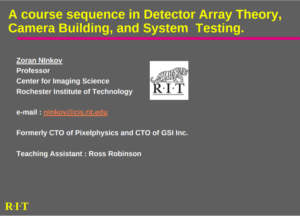
Dr. Zoran Ninkov, Professor in the Center for Imaging Science at Rochester Institute of Technology, described his year-long course in which his students learn and use basic physics and engineering to design and build a working CCD camera. For more information, see his A full-year university course sequence in Detector Array Theory, Camera Building, and System Testing.
Coupling physics to understanding the performance of detector arrays
Author: Zoran Ninkov (Rochester Institute of Technology)
Over the last few decades developments in microelectronics have led to the development of arrays of detectors that can be used to measure unprecedentedly small levels of signal. Such arrays have been used to detect electromagnetic radiation ranging in energy from the X-ray through sub-millimeter wavelengths and also particles. Perhaps nowhere have the improvements been more astonishing than in devices available for the visible part of the spectrum (400 — 1000 nm). The most successful detector array in this spectral region is the Charge Coupled Detector (CCD) whose inventors were recognized with the Nobel Prize in Physics in 2009. In this talk I will review some of the detectors and technologies that are used in low light level imaging. I will also describe a full year sequence of classes (i.e. a theory class, a CCD camera building class and a CCD camera performance measurement class) that students at the Rochester Institute of Technology can take to make them knowledgeable as to the physics underlying the operation and performance of such detector arrays. Finally I will discuss the associated laboratory classes that students must take to measure the performance of the camera they have built and what aspects of fundamental physics are integrated into their understanding. These classes have been taken by both calculus and non-calculus trained students. The classes appeal to students with both types of backgrounds as it couples an understanding of physics to something that they build and use. — SLIDES
